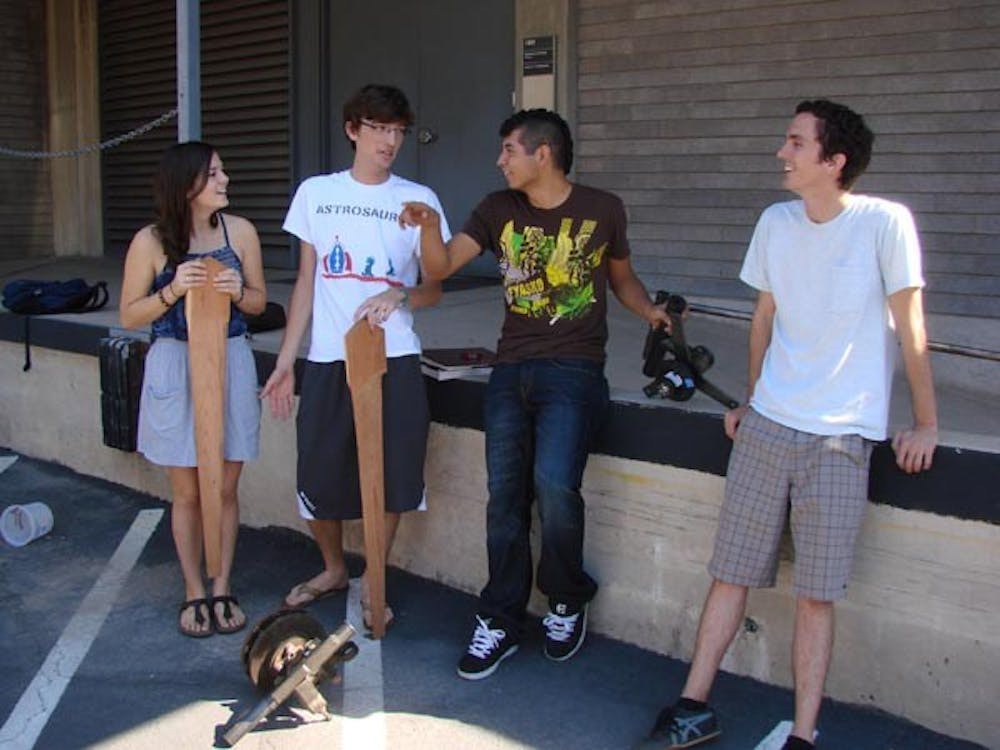A group of ASU seniors is harnessing the wind to help power rural villages in Africa.
Five students have plans to take 100 of their low-cost homemade wind turbines to villages in the African countries of Malawi and Kenya by 2016.
To reach their goal, they hope to start a nonprofit organization called “Project Upepo,” named after the word for wind in the Kiswahili language.
For now, the group members are still building the prototype in their Engineering Projects in Community Service class, and hope to have a finished model by December.
Project Upepo’s members are made up of mechanical engineering seniors Kyle Karber, Michael Hillebrand and Alex Padilla, nonprofit leadership and management senior Emily Kempe and sustainability senior Andrew Eckenrode.
They began their work in 2008 after Karber met a board member for Sustainable Resources Limited, a Phoenix nonprofit that funds and creates projects for community improvement in Malawi.
Feeling inspired, Karber gathered his friends to build something that would help, rather than just informing people about the problems.
“It’s like putting a foot forward and actually doing something,” Padilla said
Kempe said Project Upepo’s goals go beyond bringing electricity to people who don’t have it — it’s also about giving the villagers economic empowerment.
Teaching the villagers to build their own energy source is important to the team as they hope to enable women, children and the poor to find a way to improve their lives.
“The idea is more about self-empowerment,” Padilla said. “We want to help them help themselves.”
So far, the turbines have been funded with money provided by the class and with personal contributions from team members. As Project Upepo expands, members will seek additional funding through grant programs like ASU’s Innovation Challenge.
Project Upepo will make the materials for the turbines available to villagers and teach them how to build their own.
“The mission there would be to provide them not only the knowledge but the tools, resources and supplies necessary to make them successful,” Karber said.
The ease in creating the turbines is another reason that the team chose them over other options.
“I wouldn’t say it’s low-tech, but the construction is low-tech,” Hillebrand said. “They can build it themselves is the big thing.”
The turbine, which takes about a week to construct, is made of three main parts.
Three propeller blades, hand carved from 2-by-8 pieces of wood, are together 10 feet in diameter and designed to capture the power of the wind.
The blades will attach to a spinning rotor, the part that generates the electricity, made from a trailer axel and two 12-inch steel disks. Attached to the discs are rare earth magnets commonly referred to as “neo-magnets,” which have 72 pounds of magnetic pull.
Fixed in place between the magnets are nine copper coils. Electricity is generated when the magnets on the discs spin against the coils and create electromagnetism, which is the basic principle behind all generators and motors.
The third piece is the body that attaches the propeller and rotor to a 60-foot pole that lifts the turbine. This piece has what Upepo calls a “gravity furling system,” which is a long tail that juts out horizontally from the body that points the turbine into the wind.
In strong winds, the tail will automatically rotate the blades out of the wind to prevent the propellers from spinning too fast and breaking the turbine.
Once the turbine is built, it will not require any controls and very little maintenance, with the power being stored in a battery attached to the unit.
The turbines are expected to produce 1,600 kilowatts per year, about 14.5 percent of what an average American household consumes in the same time period. The villagers will mostly be using the electricity for lighting and refrigeration.
The team spent $600 on the prototype and hopes that the final turbines will cost $500 each plus another $1,000 for each tower, battery bank and charge controller.
Because most of the materials for the turbine are not readily available in Malawi, one of the group’s goals is to create a supply line for resources from South Africa and from the U.S.
After the team perfects the prototype, they will build five more turbines and test them in Malawi next summer to see how successful the project is. If things go well, they plan to return in the following summers and establish 100 turbines in Africa by December 2016.
Reach the reporter at svaltier@asu.edu





